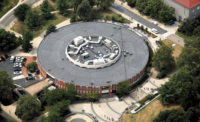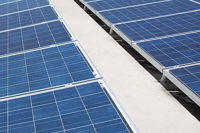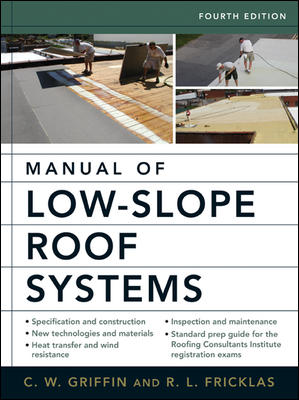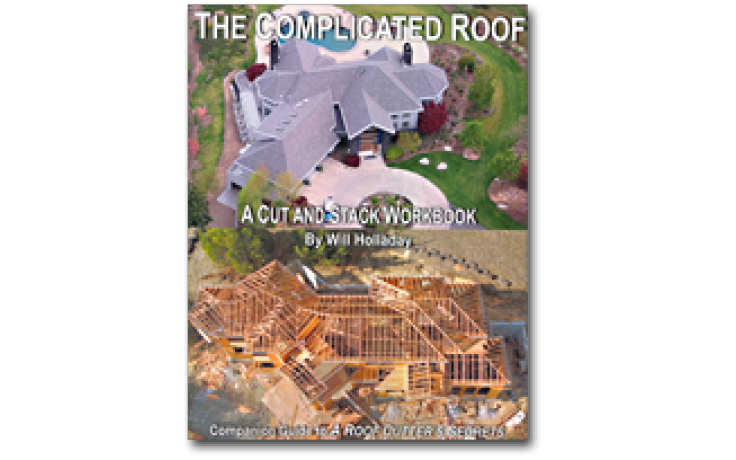Cooler Than You Think: Ballasted Roofing Systems
Ballast Assemblies Are a Cool Roof Alternative

Christie Place in Scarsdale, N.Y., has a 30,000-square-foot ballast paver and roof garden installed over its parking garage. The ballast pavers, growth media, and vegetation were installed over a 145-mil EPDM single-ply membrane with a fleece backing. Expanded polystyrene (EPS) blocking was used as a cost-effective method to build up planter boxes and add aesthetically pleasing architectural elements.

A river-washed stone ballast system tops The College of Integrated Science and Technology building at James Madison University.

A ballasted EPDM roof is shown on an elementary school in Harrisonburg, Va.



The Oxford English Dictionary defines the adjective “cool” in two ways:
- of or at a fairly low temperature.
- fashionably attractive or impressive.
Many words are used to describe ballasted roofing systems — economical, basic and durable being some of the most common. The word cool, by any definition, doesn’t usually come to mind when one thinks of ballasted EPDM roofs. One of the original single-ply roofing systems, ballasted EPDM assemblies offer lots of upside: they are quick to install, they utilize few components, they are cost-effective, and they offer superior protection against hail and UV damage. Because of these features, they’ve been tremendously popular since the 1960s. Now, almost 50 years after they were created, it is time to re-examine the advantages of ballasted assemblies because they are surprisingly cool, in more ways than one.
Cool — “Of or at a Fairly Low Temperature”
A cool roof can be a great choice for buildings in warm, Southern climates where the number of cooling degree days exceeds the number of heating degree days. The term ‘cooling degree days’ refers to the number of days that a building would need to run an air conditioning unit versus a heating unit to stay at a set temperature. When most people in the roofing industry hear the term “cool roof,” what comes to mind is an assembly that utilizes a highly reflective single-ply membrane. What many people don’t know is that ballasted EPDM roofing systems are cool roofs too.
Oak Ridge National Laboratory (ORNL), in its 2008 study “Evaluating the Energy Performance of Ballasted Roof Systems,” determined that ballasted roofs offer very similar energy benefits to conventional cool roofs, which utilize reflective white membranes. The four-year study, begun in 2004, compared data from various loadings of stone- and paver-ballasted roofs to exposed black and white membrane roofs. The study recorded temperatures, heat flows, weather conditions and solar reflectance of the various roof surfaces. This experiment was intended to clarify what influence a ballasted system has on heat flow into a building and on the roof’s surface temperature. As stated by the study, “comparisons between the ballasted and unballasted membranes allow for an assessment of whether ballasted systems perform as well as white membranes and are deserving of ‘cool roof’ status within the codes.”
The results of the Oak Ridge study were surprising to many. When completed, the study found that the surface temperature of the black EPDM membrane underneath ballast material (both river-washed stone and pavers) stayed in the 90-103 degrees Fahrenheit range, comparable to the temperatures recorded for highly reflective cool roofing membranes. This conclusion contradicts the party line that has developed among white roof champions, which is that a cool roof can only be achieved using a white membrane or coating. The ORNL study proves that a cool roof can be achieved using a dark-colored membrane.
How is this possible? Ballast material generally has a low reflectance level compared to white, reflective roofing membranes, so how can it reduce solar heat gain into a building and keep the black roofing membrane underneath so cool? It’s because ballasted systems have something reflective cool roofs don’t — the ballast material above the membrane provides thermal mass, which acts as a heat sink and helps protect the building from heat gain. Thermal mass also slows down heat flow, so the heat that does enter the building does so during off-peak hours, when energy costs are often lower.
Today, ballasted EPDM roofs using black membrane are recognized as a cool roof alternative by ASHRAE, the California Energy Commission’s Title 24 and the Chicago Building Code because these assemblies have been proven to provide many of the same energy benefits as reflective roofs. However, ballasted EPDM roofs don’t only help keep buildings cool. The thermal mass provided by the ballast can also mitigate heat loss in cooler northern climates (where heating costs are approximately five times higher than cooling costs). The ballast acts like an additional layer of insulation, which, in addition to reducing solar heat gain in hot weather, minimizes heat loss in cold weather.
So now we know that ballasted roofs not only keep buildings cool, they help keep them warm as well. The energy savings provided by this ubiquitous roofing system contributes to a smaller carbon footprint for countless commercial buildings all across the country. Another little-known fact is that ballasted assemblies not only help to keep the inside of a building cool, they can help cool the outside air as well.
Heat islands can occur in large cities where much of the vegetation has been replaced with concrete and buildings that retain heat. Urban development can actually alter weather patterns, with roads and structures absorbing a significant amount of heat during the day and radiating it back into the atmosphere. A recent article in The Fresno Bee cited a lack of trees in the city as a cause of smog and heat island concerns. The article stated, “Cities become heat islands as they trap energy from the sun in asphalt, rooftops, and buildings…” and “It’s time to talk seriously about using trees and other city-cooling ideas…” If trees help to cool cities, why not put trees on rooftops? As part of a ballasted paver plaza, small trees and gardens cool both the building and the surrounding atmosphere through evapotranspiration.
Cool —“Fashionably attractive or impressive”
With ballasted plaza paver systems and a wide variety of vegetated roof garden options, not only can you create a cool roof that helps reduce energy usage, but you can also create a cool, aesthetically pleasing, usable space on the rooftop. By combining river-washed stone ballast, concrete architectural pavers, interlocking rubber pavers and rooftop vegetation, a flat, non-usable surface can be transformed into a multifunctional plaza with numerous benefits, including:
- Improved stormwater management.
- Increased air and water purification.
- Superior sound insulation.
- Energy efficiency.
- Beautiful, usable building space.
- Possible federal, state and local tax incentives.
- Significantly extended roof life.
Paver ballast can come in a several forms. Concrete and rubber pavers are two common choices. Concrete pavers are an attractive and functional choice for plaza decks, terraces or part of an integrated roof garden assembly.
Many rubber paver options are manufactured from recycled tires to create a resilient, shock-absorbing, weather-resistant traffic surface. They can be loose-laid and interlocked over an EPDM membrane with a fleece backing and provide multi-directional drainage, without the need for a slip sheet. This unique system is ideal for rooftop terraces or in conjunction with roof gardens as walkways, creating a very comfortable and aesthetically pleasing environment.
Ballasted roofs deserve to be recognized for more than just cost-effectiveness, durability and a quick installation. They are a cool roof alternative, and offer many of the same energy benefits as a white reflective roof without the heating cost penalty or possibility for condensation issues seen in cooler Northern climates. In addition, ballasted systems can be combined with vegetated roof gardens to provide usable, beautiful space while protecting the roofing membrane below and helping to keep both the building and the atmosphere cool. What’s cooler than that?
Looking for a reprint of this article?
From high-res PDFs to custom plaques, order your copy today!











